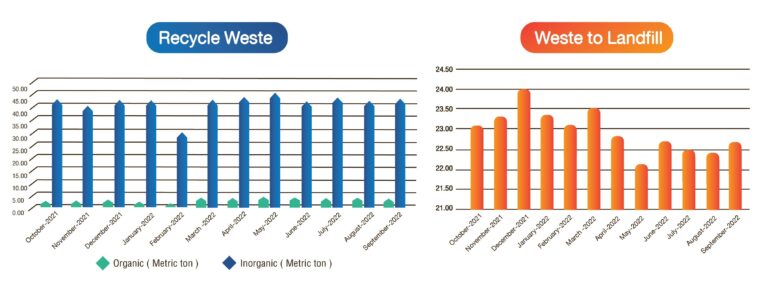Walailak University Waste Management and Recycling Policies for a Sustainable Future
Walailak University has a policy on waste disposal to measure the amount of waste sent to landfill and recycled. This policy was created as a guideline in 2019 and has been continuously implemented. In 2022, this policy was revised and updated. The guidelines and waste management practices are aimed at reducing the amount of waste sent to landfill. In addition, students, employees, and staff of the university are aware of the amount of single-use plastic used within the university, aiming to minimize its environmental impact both on the terrestrial and marine ecosystems.
Currently, the university has a comprehensive waste management system in place under the Green University policy, with the goal of making zero waste management. This approach takes into consideration the economic, social, and environmental aspects to ensure sustainability in line with Sustainable Development Goals (SDGs). Walailak University has implemented a waste management project that involves segregating waste at various points within the university buildings for convenient disposal. This is due to the fact that different types of waste require distinct disposal methods. Moreover, improper disposal of organic waste can lead to environmental contamination and adversely affect the health of the university’s population.

In 2022, the university measured the quantity of waste, categorizing it into different types. These categories include general waste, biodegradable organic waste that naturally decomposes, recyclable waste, hazardous waste, and infectious waste. Each type of waste has its own distinct disposal method, and they can be broadly categorized into two main methods:
Recycled Waste
In 2022, the amount of recycled waste was 536.635 tons, accounting for 66.07% of the total waste. Even though some recyclable waste, e.g., glass, metal, and tile, cannot be recycled by Walailak University due to the lack of higher technologies, WU solved the problem by selling all the waste to the industrial plants of private companies. That action ensured the commitment to reducing waste by selling it instead of sending it to landfills.
In addition, WU has utilized Refuse-derived Fuel (RDF) produced by the waste on campus for road construction and composting. The ashes of solid waste that have undergone Refuse-derived Fuel creation have been utilized to produce animal feed, especially for pig farming.
Sanitary Landfill
In 2022, the amount of waste sent to landfills at WU was 275.645 tons, accounting for 33.9% of the total waste created on campus. All the waste sent to landfills was waste that could not be disposed of by incineration. The waste included fragments of metal, tile, and rocks. From the past until the present, the waste sorting method at WU has not affected the public health of local communities or the environment surrounding the campus. In addition, waste management is always an element integrated with education to raise awareness about waste sorting and mobilize students to be good global citizens.


The segregation and tracking of various types of waste are beneficial for recycling materials that can be reused in their respective production processes. This approach reduces the daily waste generation, thus lowering environmental pollution. It also provides valuable benefits by repurposing waste materials instead of disposing of them. Furthermore, in addition to reducing waste volumes, it helps conserve resources, making resource utilization more efficient and environmentally friendly.
Goal 12: Responsible consumption and production


